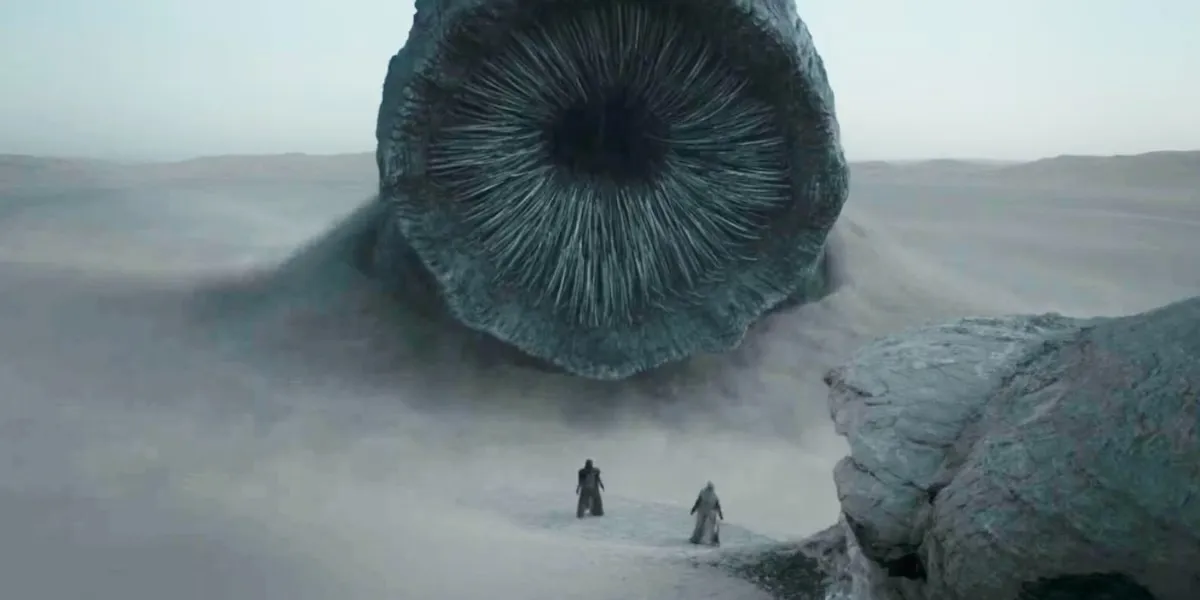Dune: Part Two has plenty of epic moments, made all the more exciting by the vast scope of Denis Villeneuve’s storytelling style. Giant spaceships! Huge worms! Endless deserts! But here’s why one very tight shot is my favorite in the entire film.
Warning: spoilers for Dune: Part Two ahead!
In Dune: Part Two, Paul Atreides (Timothée Chalamet) has to prove himself to the Fremen after he and his mother Jessica (Rebecca Ferguson) join one of their communities in the desert of Arrakis. In order to be accepted among them—especially since Jessica and the other Bene Gesserit are angling to make Paul the Fremen’s messiah—Paul has to prove that he can ride a sandworm. Paul runs to the top of a dune (hey, is that where the series’ name comes from?), sets up the thumper that will call a sandworm to him, and gets out his riding hooks.
Soon, the biggest worm in the history of worms starts barreling toward him. Paul leaps on top and manages to grab on with one of his hooks. What follows is a frenetic series of shots dropping us right into the middle of the chaos Paul is experiencing. We see flying sand everywhere, and we hear the howl of wind rushing past him as he scrambles to get a better hold on the worm. We can almost feel the jostling as he fights to stay on. It’s very hard to tell what’s happening while Paul struggles to gain purchase on the worm’s back.
All of a sudden, for only about a second, we see a couple of holes in the worm’s skin open and close. It looks like they’re breathing holes—and they’re the exact reason I love Villeneuve’s visual style so much.
Villeneuve is a master of tight perspectives
As Thomas Flight points out in his video analyzing Dune: Part One’s visual effects, Denis Villeneuve is careful to always ground his cinematography within the perspective of his characters. Instead of overusing wide shots that give the audience a plain picture of what’s going on in a scene, Villeneuve stays inside of his characters’ point of view whenever he can.
For example, when the Bene Gesserit’s ship lands outside of Paul’s home on Caladan in Dune: Part One, it appears as a dark mass in the sky with blinding spotlights. We don’t get a clear look at the ship, because Jessica, who’s standing beneath it, doesn’t have that vantage point herself. By showing the ship as a massive shape looming over us, Villeneuve shows us what Jessica is seeing. It makes the scene feel more real and personal.
Likewise, as Paul is scrabbling on the worm’s back amidst the chaos of all that sand and wind, we suddenly see those breathing holes. Would Paul notice them as he was struggling? I think he would. I think it’s exactly the kind of strange, random detail that might pop out and stick with you when you’re having an experience like Paul’s. The shot makes both the worm and Paul’s struggle feel viscerally real. Plus, it emphasizes how close Paul is to the worm: He’s close enough to see details that we haven’t been able to access thus far.
Dune: Part Two, like other films in Villeneuve’s catalog, is filled with fascinating moments like this one. (Another classic Villeneuve moment I often find myself mulling over is the dream sequence in Arrival, when the camera cuts to a heptopod suddenly looming over us.) His filmmaking style is a good reminder that you don’t necessarily need gigantic VFX budgets to make your movies pop, although those can’t hurt. All you need is a keen eye for the details that will immerse the viewer in the story.
(featured image: Warner Bros.)










Published: Mar 5, 2024 9:13 PM UTC